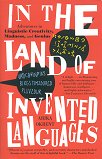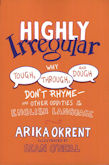As if there weren't enough languages in the world, some people seemed compelled to invent new ones. Mostly because the ones we have aren't good enough: they're illogical in structure, hard to learn, divisive, just not up to scratch somehow. In this wonderful book, Okrent takes us on a dizzying tour of the darkest depths, major follies, and minor victories of a whole slew of language inventors. The book is divided into five main sections, covering five main styles of language design. This semi-historical design serves to highlight the rise and fall in fashions in invented languages, and shows that these inventions weren't happening in a vacuum.
We get the first attempt at "logical" languages, including John Wilkins' 600 page classification of everything, which was intended to be the basis of removing ambiguity. Here we learn that a "dog" is a "Beast XVIII > viviparous [as opposed to egg-laying] > clawed > rapacious > oblong-headed [as opposed to round-headed] V > European [as opposed to exotic] > terrestrial [as opposed to aquatic] > bigger kind noted for > docility [as opposed to wildness]", and that "shit" is "Motion XXXI > purgation IV > serous and watry [as opposed to vaporous and windy] > from the guts > downward". These classifications don't precisely trip off the tongue, so Wilkins invented a way of pronouncing them, by assigning letters and syllables to branches of the tree. So to say these words, you just walk down the correct branch of the tree, sounding out the pronunciation: the route for "dog" becomes "Zita", that for "shit" becomes "Cepuhws". And to understand what a word means, you can recreate its position in the tree from its name. (While reading this section, I was irresistibly reminded of Borges' famously absurd classification of animals, and so was delighted to learn here that it actually appears in an article of his entitled "The Analytical Language of John Wilkins".) Complete lack of ambiguity achieved. If the concept you want is in the hierarchy, of course.
But, alas, it would not be. History forgets.
And today, alas, we have novel forms of this ridiculous idea, enshrined in some of the more naive object-oriented classification schemes and some of the more over-simplistic ontologies, which strive for the ever-elusive "one true hierarchy".
After languages to promote unambiguous thought came languages to promote peace and unity. These are the better-known invented languages, such as Volapük, Esperanto, and Ido. What is amazing here is the sheer number of these languages that were invented with bold assertions of universal peace, and then promptly withered in near total obscurity. Esperanto is essentially the only one to survive to any degree. Also included in this section is Modern Hebrew, and how it can be considered as an invented language, the unlikliness of its genesis, and the unique circumstances that led to its survival.
The next section was something I had never come across before: Blissymbolics, a symbolic language invented for the usual kind of reason, but that prospered in a unique environment: that of allowing children and adults who cannot speak and can barely move (for example, those with cerebral palsy) to begin to communicate. The story is heartwarming and horrifying by turns: heartwarming in the way the children blossomed once they could communicate; horrifying in the reaction of Bliss to the work. (There seems to be a problem with language inventors: they are trying to improve language, so when someone uses it in a non-conformist way that doesn't meet their vision, as here, they get upset, in a spectrum ranging from litigation to full-blown paranoid hysteria.) This section includes some fascinating stuff about Chinese writing and Sign Language.
History then sees a resurgence in logical languages. Now, however, these have become rather more sophisticated that simple hierarchical classifications languages: they are attempting to embody a culturally neutral and comprehensive ontology. Loglan started it off, initially invented as a way to test the Sapir-Whorf hypothesis, that language affects thought. Although starting with this fairly neutral-sounding rationale, it eventually degenerated into typical squabbles over priority, court cases, and a spin-off alternative: Lojban. This language analyses and categorises the logical meaning of utterances: There are at least twenty ways to say "and" in Lojban. Does Lojban affect thought? Does it support the Sapir-Whorf hypothesis? Okrent recounts an amusing experience relating to this:
Was this some kind of Whorfian effect? Well, no. It was more of a Freudian effect---like when you read a little Freud and suddenly everything starts to look like a penis. If someone keeps calling your attention to hidden meanings, or distinctions in meanings, you may start to see them. Your view of the world can be shaped by lots of things, but the Whorfian hypothesis wants only to know which parts are shaped by the language you speak. And I did not speak Lojban. In fact, after reading the grammar, I was pretty sure it was impossible for anyone to speak it.
(I must confess that I had the same reaction to the number 6 question!) Speakers do speak it, but very slowly, and there is a reasonably-sized community, unsurprisingly with a high proportion of mathematicians and computer programmers.
This anecdote illustrates a feature that brings the book alive: Okrent is a linguist who loves languages, natural or artificial, and she gets down and dirty with them, no matter how silly they may seem. She learns them. She translates sentences into them. She goes to conferences and fan conventions about them. She doesn't sneer at them, or their inventors. Nowhere is this illustrated more clearly than in the final section, which revolves around Klingon, which Okrent has learnt enough to pass the level 1 exam.
This is a super book, with loads of fascinating information, told in a light, amusing, and informed style. I have an interest in languages (which doesn't extend as far as actually learning them: for example, my copies of General Semantics and Lojban remain firmly unperused; I can barely be said even to dabble), and have read several books about them: this is one of the best. I will definitely be following up some items in the bibliography.

